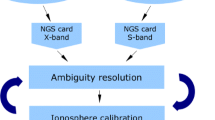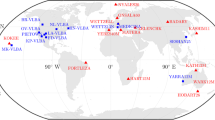Abstract
UT1–UTC is one of the Earth orientation parameters (EOP) that can only be determined by very long baseline interferometry (VLBI), observing distant celestial sources to measure the Earth rotation angle. Earth orbiting satellites tracked from Earth are insensitive to this angle, and the orbit determination and time synchronization (ODTS) procedure for GNSS satellites hence requires the UT1–UTC as an input. Today, UT1–UTC is provided by the International Earth Rotation and Reference Systems Service (IERS). A VLBI transmitter (VT) onboard GNSS satellites would, as an alternative way, allow the direct transfer of this information as an integrated step to the ODTS process thanks to the space-tie established between the VLBI and GNSS techniques. Here, we investigate the transfer quality of the UT1–UTC in such a concept by considering different VLBI baselines. In the simulations, we assume observations from a VT onboard a Galileo satellite together with quasar observations acquired with the same VLBI ground stations during a session and therewith allowing to directly transfer UT1–UTC to the GNSS constellation. The geometrical setting of the Galileo satellite with respect to the ground stations is quantified by the UT1–UTC dilution of precision (UDOP). Our simulations show that it is feasible to transfer UT1–UTC with a precision of about \(30~\upmu \text {s}\) for a long VLBI baseline where the UT1–UTC precision estimated from quasar observations is \(20~\upmu \text {s}\). Using VLBI networks instead of a single baseline can improve the transfer precision further by more than 20 \(\%\) depending on the baseline selection.









Similar content being viewed by others
Data availability
The multi-GNSS datasets used during the current study are available from: http://ftp.aiub.unibe.ch/CODE_MGEX/. Calculations are based on Bernese GNSS Software Version 5.2 licensed from University of Bern.
References
Anderson JM, Beyerle G, Glaser S, Liu L, Männel B, Nilsson T, Heinkelmann R, Schuh H (2018) Simulations of VLBI observations of a geodetic satellite providing co-location in space. J Geod 92(9):1023–1046. https://doi.org/10.1007/s00190-018-1115-5
Bar-Sever Y, Haines B, Wu S (2009) The geodetic reference antenna in space (GRASP) mission concept. In: EGU general assembly conference abstracts, p 1645
Belli F (2020) Transfer of absolute orientation to Galileo orbits with VLBI. PhD thesis, Master thesis, Technical University of Munich
Beutler G, Brockmann E, Gurtner W, Hugentobler U, Mervart L, Rothacher M, Verdun A (1994) Extended orbit modeling techniques at the CODE processing center of the international GPS service for geodynamics (IGS): theory and initial results. Manuscr Geod 19(6):367–386
Biancale R, Pollet A, Coulot D, Mandea M (2017) E-GRASP/Eratosthenes: a mission proposal for millimetric TRF realization. In: EGU general assembly conference abstracts, p 8752
Bruni S, Rebischung P, Zerbini S, Altamimi Z, Errico M, Santi E (2017) Assessment of the possible contribution of space ties on-board GNSS satellites to the terrestrial reference frame. J Geod 92(4):383–399. https://doi.org/10.1007/s00190-017-1069-z
Dach R, Andritsch F, Arnold D, Bertone S, Fridez P, Jäggi A, Jean Y, Maier A, Mervart L, Meyer U, Orliac E, Geist E, Prange L, Scaramuzza S, Schaer S, Sidorov D, Susnik A, Villiger A, Walser P, Thaller D (2015) Bernese GNSS software version 5.2. https://doi.org/10.7892/boris.72297
Dickey JM (2010) How and Why to do VLBI on GPS. arXiv:1008.4642
Enderle W, Gini F, Boomkamp H, Parker JJ, Ashman BW, Welch BW, Koch M, Sands OS (2018) Space user visibility benefits of the multi-gnss space service volume: an internationally-coordinated, global and mission-specific analysis. In: Proceedings of the 31st international technical meeting of the satellite division of the institute of navigation (ION GNSS+ 2018), pp 1191–1207
Haas R, Sekido M, Hobiger T, Kondo T, Kurihara S, Tanimoto D, Kokado K, Wagner J, Ritakari J, Mujunen A (2010) Ultra-rapid DUT1-observations with e-VLBI. Artif Satell. https://doi.org/10.2478/v10018-010-0007-6
Haas R, Neidhardt A, Kodet J, Plötz C, Schreiber U, Kronschnabl G, Pogrebenko S, Duev D, Casey S, Marti-Vidal I et al (2014) The Wettzell-Onsala G130128 experiment—VLBI-observations of a GLONASS satellite. In: Behrend D, Baver KD, Armstrong KL (eds) IVS 2014 general meeting proceedings’’ VGOS: the new VLBI network. Science Press, Beijing, pp 451–455
Hase H (1999) Phase centre determinations at GPS-satellites with VLBI. Eur VLBI Geod Astrom 13:273–277
Hellerschmied A, Böhm J, Kwak Y, McCallum J, Plank L (2016) VLBI observations of GNSS satellites on the baseline Hobart-Ceduna. In: EGU General assembly conference abstracts, EGU general assembly conference abstracts, pp EPSC2016–8895
Hellerschmied A, Böhm J, Neidhardt A, Kodet J, Haas R, Plank L (2015) Scheduling VLBI observations to satellites with VieVS. https://doi.org/10.1007/1345_2015_183
Jaradat A, Jaron F, Gruber J, Nothnagel A (2021) Considerations of VLBI transmitters on Galileo satellites. Adv Space Res. https://doi.org/10.1016/j.asr.2021.04.048
Klopotek G, Hobiger T, Haas R, Otsubo T (2020) Geodetic VLBI for precise orbit determination of earth satellites: a simulation study. J Geod. https://doi.org/10.1007/s00190-020-01381-9
Malkin ZM (2020) Statistical analysis of the results of 20 years of activity of the international VLBI service for geodesy and astrometry. Astron Rep 64(2):168–188. https://doi.org/10.1134/s1063772920020043
Nerem R, Bar-Sever YE, Grasp Team (2011) The geodetic reference antenna in space (GRASP)—a mission to enhance the terrestrial reference frame. In: AGU fall meeting abstracts, vol 2011, pp G51B–04
Niell A, Barrett J, Burns A, Cappallo R, Corey B, Derome M, Eckert C, Elosegui P, McWhirter R, Poirier M et al (2018) Demonstration of a broadband very long baseline interferometer system: a new instrument for high-precision space geodesy. Radio Sci 53(10):1269–1291
Nothnagel A, Artz T, Behrend D, Malkin Z (2016) International VLBI service for geodesy and astrometry. J Geod 91(7):711–721. https://doi.org/10.1007/s00190-016-0950-5
Petrachenko B, Corey B, Himwich E, Ma C, Malkin Z, Niell A, Shaffer D, Vandenberg N (2004) Vlbi2010: networks and observing strategies. In: International VLBI service for geodesy and astrometry 2004 general meeting proceedings
Plag HP, Pearlman M (2007) The global geodetic observing system: meeting the requirements of a global society on a changing planet in 2020 the reference document. Int Assoc Geod
Plank L, Böhm J, Schuh H (2014) Precise station positions from VLBI observations to satellites: a simulation study. J Geod 88(7):659–673
Plank L, Hellerschmied A, McCallum J, Böhm J, Lovell J (2017) VLBI observations of GNSS-satellites: from scheduling to analysis. J Geod 91(7):867–880. https://doi.org/10.1007/s00190-016-0992-8
Plank L, Böhm J, Schuh H (2015) Simulated VLBI satellite tracking of the GNSS constellation: observing strategies. In: International association of geodesy symposia, Springer, pp 85–90. https://doi.org/10.1007/1345_2015_87
Schuh H, Behrend D (2012) VLBI: a fascinating technique for geodesy and astrometry. J Geodyn 61:68–80
Swanson E (1978) Geometric dilution of precision, Navigation. J Inst Navig 25(4):425–429
Tornatore V, Haas R, Casey S, Duev D, Pogrebenko S, Calvés GM (2014) Direct VLBI observations of global navigation satellite system signals. In: Earth on the edge: science for a sustainable planet, Springer, pp 247–252
Tornatore V, Haas R, Molera G, Pogrebenko S (2010) Planning of an experiment for VLBI tracking of GNSS satellites. In: Proceedings of the 6th IVS general meeting, pp 70–74
Vondrák J, Richter B (2004) International earth rotation and reference systems service (IERS) web: www.iers.org. J Geod 77(10-11):585–678, https://doi.org/10.1007/s00190-003-0370-1
Acknowledgements
This work was partially supported by ESA through the Project on VLBI transmitter for G2G (Galileo 2nd Generation, Contract No. 40000129356/19/NL/AS), with Antwerp Space as Prime Contractor. Funded by EU; ESA has received funds in its quality as funding body under the European Union’s Horizon 2020 research and innovation programme. This work has also received funding from the European Research Council (ERC) under the European Union’s Horizon 2020 research and innovation programme (Grant Agreements Nos. 670874 and 855677).
Author information
Authors and Affiliations
Contributions
UH and OK defined the research topic, HS ran the simulations with the support from UH, and all authors contributed to the writing of the manuscript.
Corresponding author
Rights and permissions
Springer Nature or its licensor (e.g. a society or other partner) holds exclusive rights to this article under a publishing agreement with the author(s) or other rightsholder(s); author self-archiving of the accepted manuscript version of this article is solely governed by the terms of such publishing agreement and applicable law.
About this article
Cite this article
Sert, H., Hugentobler, U., Karatekin, O. et al. Potential of UT1–UTC transfer to the Galileo constellation using onboard VLBI transmitters. J Geod 96, 83 (2022). https://doi.org/10.1007/s00190-022-01675-0
Received:
Accepted:
Published:
DOI: https://doi.org/10.1007/s00190-022-01675-0




